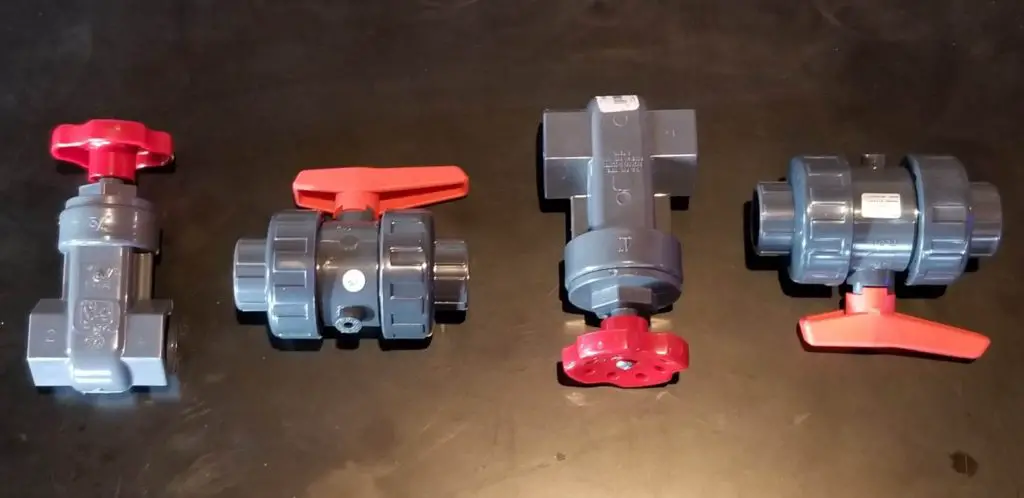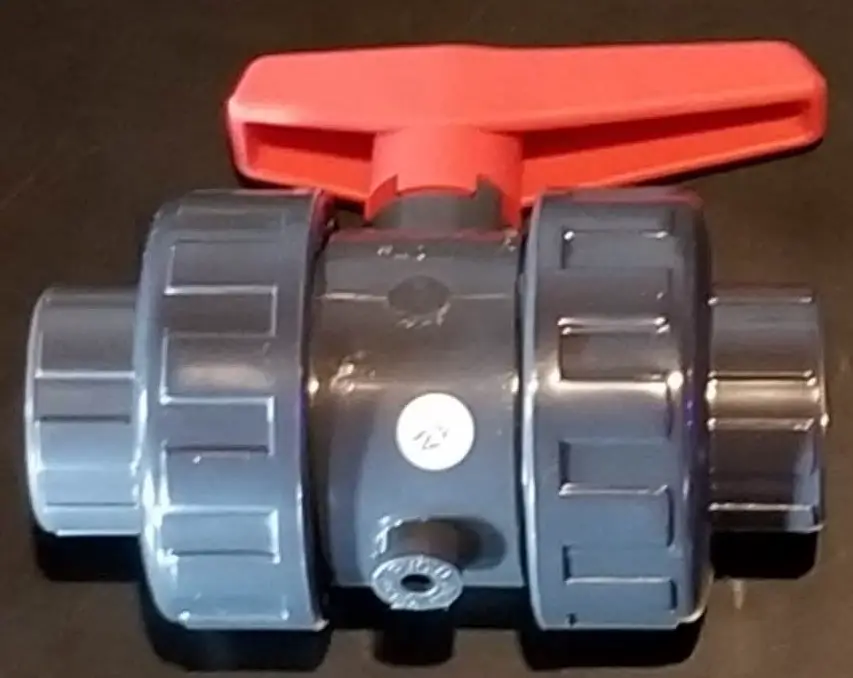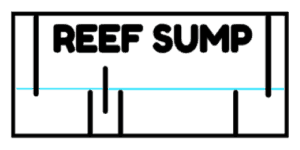
Sometimes you will need to manually restrict the flow of water through your reef aquarium’s lines. Two plumbing products that will help you accomplish this are gate valves and ball valves. You will want to use a gate valve when needing to fine-tune that amount of flow going through the valve. Ball valves should be used when completely restricting or allowing water flow through the valve. The #1 place for a gate valve is on your drain line or lines on your tank. Ball valves can be used in locations where you simply need to turn off the flow to an area or piece of equipment. Read on to find out more about using gate valves and ball valves in your reef aquarium.
What is a Gate Valve?

A gate valve is a plumbing device that is run in line with a pipe and can be adjusted to increase or decrease water flow through the line. Most gate valves used in aquariums are made of PVC and come in various connection types and sizes. Flow adjustment is usually accomplished by an internal gate that is manually adjusted up or down by turning the valves dial. As the dial is opened the gate lifts and allows water to flow through the space underneath the gate. Manual turns on the dial slowly moves the gate up and down making fine adjustments to flow possible. A fully opened gate valve will restrict very little flow through the line and a closed valve should not allow any water through.
What is a Ball Valve?
A ball valve is similar to a gate valve where its main function is to restrict or allow flow through a line. Ball valves used in reef aquariums are made of PVC. As the name suggests, a ball valve uses a ball with a hole within the valve to allow or restrict flow when the ball valve’s knob is manually turned. When the valve is open the hole in the ball allows water to flow through the line. When the valve is closed, the hole in the ball is covered by the walls of the pipe restricting water from flowing through the pipe. The hole on a ball is much smaller than on a gate valve so small changes when turning the know have a greater impact on the flow going through the valve making fine-tuning harder.

When to use Gate Valves on Your Aquarium
Use a gate valve when you need to finely adjust the flow through the line. The number one place to use gate valves is on the main drain line of your reef. A gate valve will allow you to adjust the flow draining into the sump allowing you to match the flow to your return pumps. The right drain flow and return flow will allow you to have a quiet operation, the right sump water level, and a good turnover rate through the sump. It is especially important to use a gate valve in two popular drain setups, the Herbie overflow method, and the Bean Animal overflow method. Both of these overflow methods are renowned in the hobby for their quiet operation and safety features. Both of these methods were brought to the hobby by dedicated reefers and are named after their forum names.
The Herbie method involves an overflow box with two standpipes inside the overflow box that drain water into the sump. One standpipe is used as the main drain and the other standpipe and line are set up as an emergency drain. The main standpipe should sit below the emergency drain and acts as the primary siphon drain for the tank. The main standpipe can get clogged by something like a snail. When this happens the water level in the box will rise to the level of the emergency drain and the emergency drain will kick in and drain water into the sump rather than onto the floor. For the most efficient operation and least amount of noise, the water level within the overflow box should be adjusted right to the top of the emergency drain standpipe. This is where the gate valve comes in. The gate valve should be placed on the main drain line in a Herbie overflow setup. Opening and closing the gate valve allows for the adjustment of the water level within the overflow box. Very small adjustments will make the water level rise and fall quickly in the box. Attempting to do this with a ball valve can be a maddening task as small adjustments are hard to make with a ball valve.
In a Bean Animal setup, it is very much the same as a Herbie except there are three standpipes in the overflow box. Just like the Herbie, there is the main drain and an emergency drain, the additional drain is a Durso pipe. A Durso pipe is another type of drain that uses an elbow and a hole to vent air that helps with quiet operation. The Bean Animal setup allows for two drains and is very quiet while draining large amounts of water from the display tank which is especially helpful on large tanks. A gate valve is again used on the main drain line, it is not necessary on the Durso secondary drain. Also like the Herbie setup, the gate valve is used to adjust the water level in the overflow to dial in the drain and ensure quiet efficient draining.
Another place where you might find a gate valve is on protein skimmers. A lot of protein skimmers on the market include high-quality gate valves. The gate valve on skimmers is used to adjust the water level within the skimmer body. Reef Octopus skimmers often include a gate valve to fine-tune the water level allowing you to skim wet or dry as needed. I currently use a Reef Octopus Classic 202-S protein skimmer on my 210 Gallon Aqueon Big Fish Mixed Reef Tank and the valve works great to adjust the water level and operates pretty quietly for the size of the skimmer.
When to use Ball Valves on Your Aquarium
Use ball valves on your aquarium when you need to have flow all on or all off only. A ball valve can be handy where you have equipment plumbed directly into a return line. If you need to disconnect your equipment it helps to have a ball valve that you can shut off, disconnect, and remove the equipment for maintenance or replacing. An example might be a plumbed media reactor being feed by a return pump that needs its media changed. You can simply close the ball valve, disconnect the canister, refill the media, reconnect, and open the valve to have the reactor up and running again in short order. If you have an external return pump, a ball valve between the sump and pump is nice to have to service the pump when needed. Ball valves can also be used in RO/DI systems and even on the end of your hose when filling freshwater containers.
Another great spot for ball valves is on a manifold in your plumbing. An aquarium manifold is typically in line with a return line that can branch out to other lines for various functions. You never know when you’ll need to have a separate line for a piece of equipment or even another plumbed-in tank like a frag tank. For a manifold, you can use PVC T connections with a ball valve connected off the T. When you are ready to use the line simply plumb in your equipment or second tank and open the valve when it is ready for operation. Having this plumbed and ready to go can make it easy to add upgrades or modify your system when needed. Keep in mind that if you add lines you may need a bigger return pump to move water through more distance and equipment.
How to Make a Home Aquarium Manifold
Advantages and Disadvantages of Gate Valves and Ball Valves
Plumbing usually isn’t the most exciting feature of a reef tank, however, I find gate valves to be one of the coolest plumbing accessories. A visitor seeing a gate valve with a nice red handle screams ohh what does that do. That discussion can then turn into a full master class on aquarium plumbing and what a Herbie/Bean Animal drain is. It is also a point where you get to interact with your tank by using the gate valve to fine-tune the water level and get it to a point where it operates silently. Gate valves for aquariums can be hard to find locally and most of the time you will need to order them online unless you have a well-stocked plumbing store or a local fish store that does installations. Another disadvantage of gate valves is cost. Gate valves are costly compared to the normal ball valve. If comparing directly to a ball valve, it also takes longer to shut off a gate valve as you have to turn the handle more times to fully close or open the gate.
One advantage of a ball valve is that you can easily find these at hardware stores in town and they are usually reasonably priced for a normal ball valve. However, I don’t recommend using the run-of-the-mill ball valve if you are plumbing it directly into your tanks system. It is usually better to get a high-quality ball valve if using it on your aquarium. Cheap ball valves can get hard to close over time when used with saltwater. Compared to a gate valve, ball valves are not good for fine adjustment of water flow.
Where to get Gate Valves and Ball Valves
Gate valves can be a little hard to find locally. If you need a gate valve locally, usually the place to check is your local fish store. Sometimes your lfs will have one on hand perhaps from a previous build project. Another place to check is specialty plumbing stores. I haven’t had the best luck finding these at any other place in town. The easiest place to find a gate valve is online. Gate valves are sold by most aquarium online stores and can also be found on Amazon. You’ll want to make sure to purchase the right size for your drain line and the appropriate connection for your setup. Also, make sure to purchase all PVC versions of gate valves. Spears gate valves are highly regarded in the hobby.
Ball valves can be found where plumbing devices are sold like hardware stores. Keep in mind that not all ball valves are created equally, especially in the reef aquarium hobby. Saltwater can have a big impact on the operation of a ball valve. At some point, cheap ball valves can be almost impossible to open and close. I’ve seen examples where people have put so much pressure on their ball valve trying to close it that they’ve cracked their sump. Cheap hardware store ball valves can be used where it is not engaged often, is being used with freshwater, or can be easily replaced as needed. If you intend to use a ball valve as part of your display’s main plumbing system I recommend using a high-quality ball valve. These can be found online through aquarium stores and on Amazon. A reputable brand is Cepex. These are high quality and should last you years on your tank. Some of these also come with true union setups that allow you to easily disconnect the valve for maintenance. Again high-quality ball valves are most commonly found online.
Some Gate Valve and Ball Valve Options
Spears PVC Gate Valve
Gate Valve, Buna-N O-Ring Material, Size 1 In, Socket Weld Connection, Material of Construction PVC, Top of Handle to Inlet Center 4.31 In, Inlet to Outlet Length 3.31 In, Rated For 200 psi
Spears PVC Ball Valve
The Spears 1829 series PVC ball valve is made of PVC (polyvinyl chloride) for corrosion resistance, light weight, and high strength, and it has EPDM (ethylene propylene diene monomer) O-rings for good resistance to weathering, ozone, UV, electricity, oils, water, steam, and some solvents.
Conclusion
Both gate valves and ball valves have their places in the reef aquarium hobby. It is best to use a gate valve on the main drain lines of a Herbie or Bean Animal overflow setup. Save yourself the hassle by not even trying a ball valve for fine adjustment of flow. Use a ball valve for points in your system where you will need to completely have on or off through the line. Another best practice is to use a high-quality ball valve when it is a part of your main plumbing system on the tank. Another helpful best practice is to strategically place unions that will allow you to easily disconnect valves when they need to be replaced or serviced. Plumbing is one of those things where shortcuts can be taken, but it is not advised with a reef aquarium as it can lead to catastrophic failures on your tank and damage to your home. Choose the right valve for the job the first time and don’t skimp on plumbing accessory quality, it will pay dividends in the long run.


